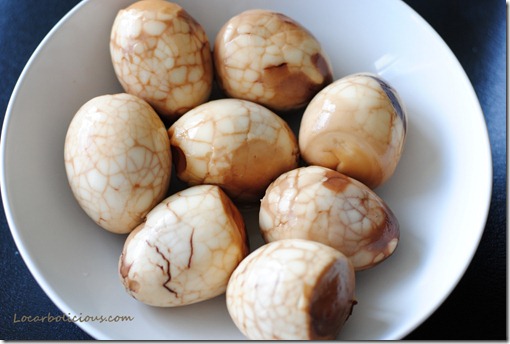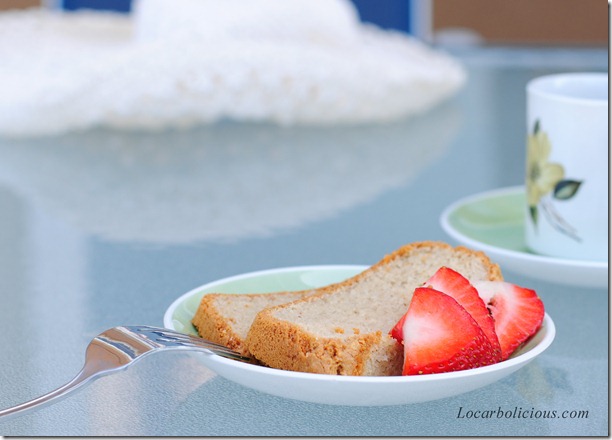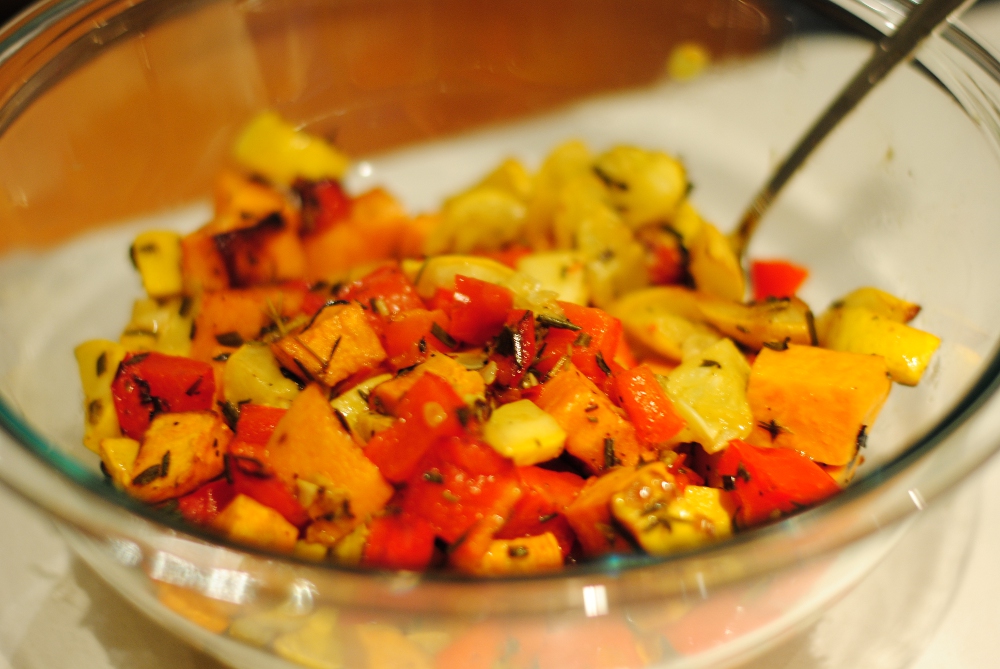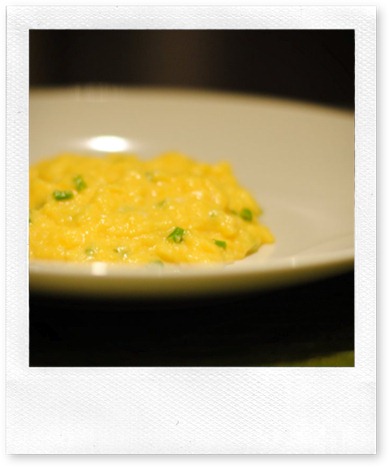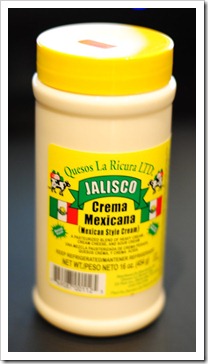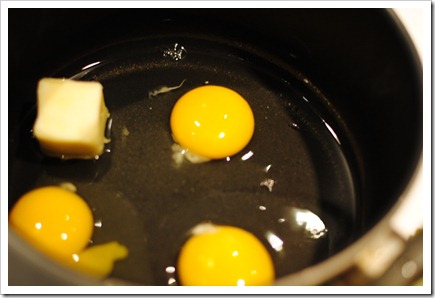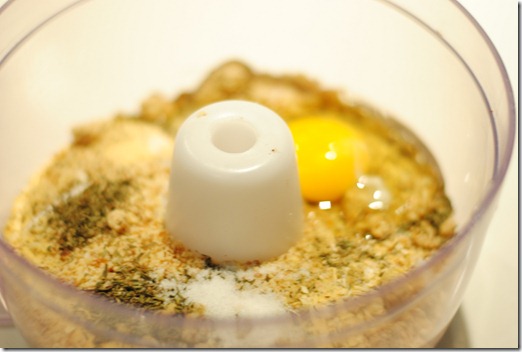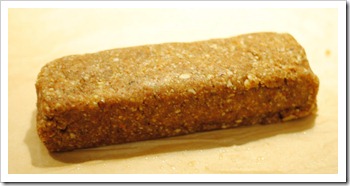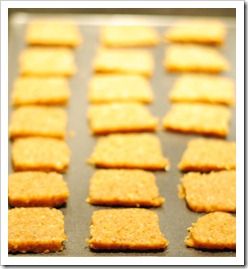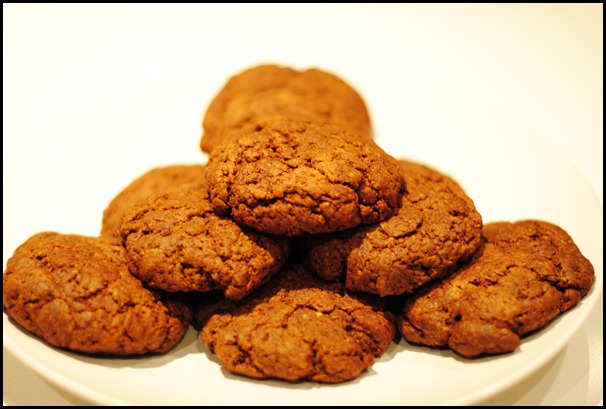Moved to AncestralChef.com
I have moved to blogging at AncestralChef.com.
Please follow me there for more delicious recipes!! If you haven’t seen my new FREE iPad e-book, then check it out on your iPad here. You can also reach me on Twitter, Facebook, Pinterest, or Google+.
I am also featured in the first issue of Paleo Living Magazine for iPad (full of videos, interactivity, and gorgeous pictures!), and you can download the first issue for FREE here.
Vegged Up Burgers
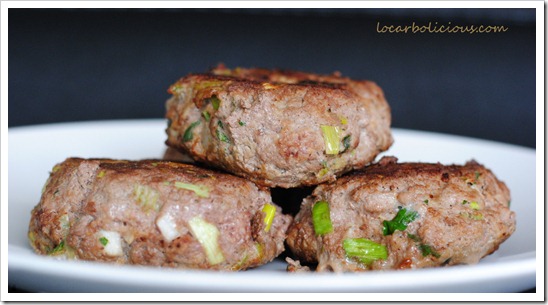
I love adding some vegetables to my burgers – it makes me eat more vegetables and adds great taste to the burgers! These are so simple to make as well regardless of whether you even have a grill. I often just pan fry them. They also store well in the fridge so I often cook a bunch of them and store them in the fridge. You can add in all sorts of vegetables into the patties – this time I added some leeks and parsley. I also added some salt and pepper and eggs to make the meat stick to the veggies well.
Ingredients: For 3lbs of meat, I used 2 leeks, a handful of parsley, and 3 eggs.
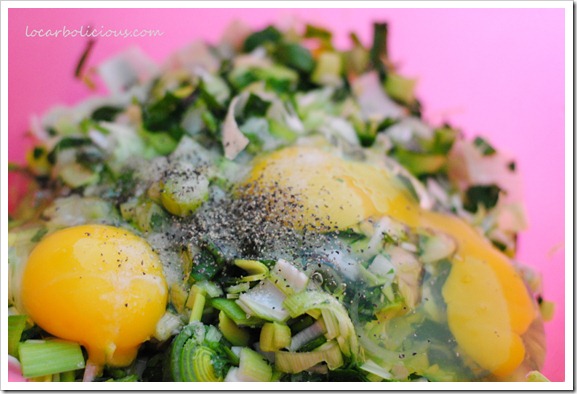
Directions: Mix everything together well and form the meat patties. Then simply grill or pan fry in some coconut oil. It’s that simple!
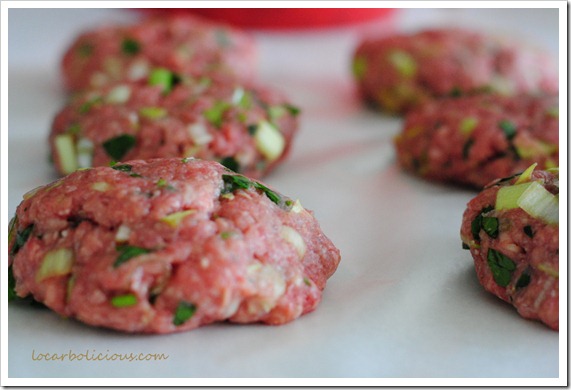
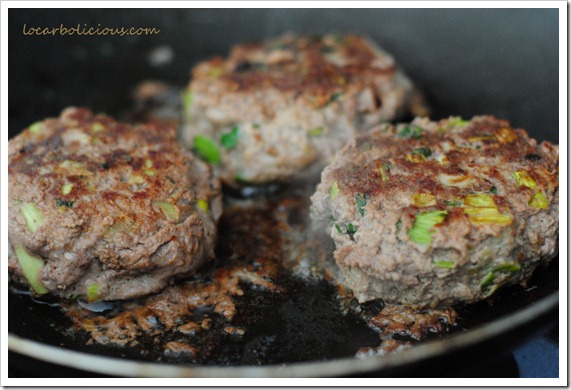
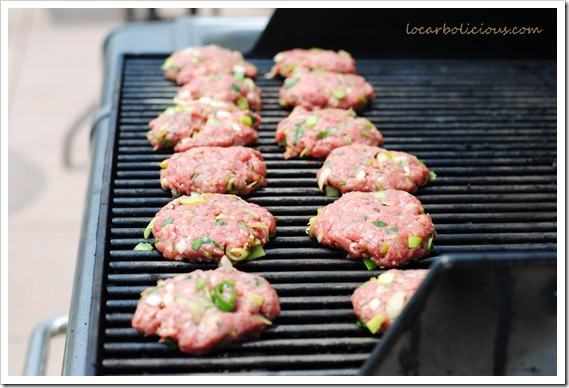
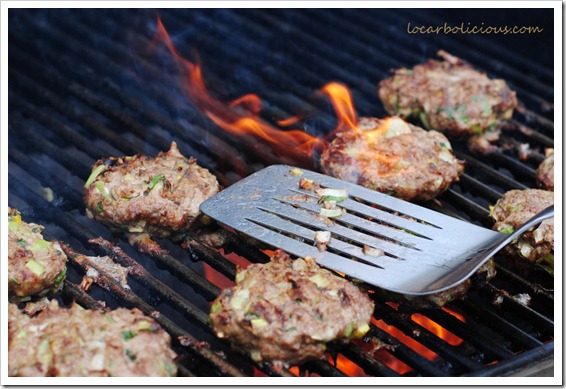
Caffeinated Eggs
Who has time to make coffee and cook eggs! Now, you can pre-make caffeinated eggs to make your breakfasts healthy as well as fast! This recipe is simple to make, delicious to eat, and handy to take with you on the go. 
It’s actually a traditional Asian recipe and the recipe itself can vary depending on who you ask. The crucial ingredients are: (1) the eggs (of course!), (2) soy sauce (or coconut aminos), and (3) tea. The spices also add quite a bit of flavor, but if you have those 3 crucial ingredients, then this will be a breeze!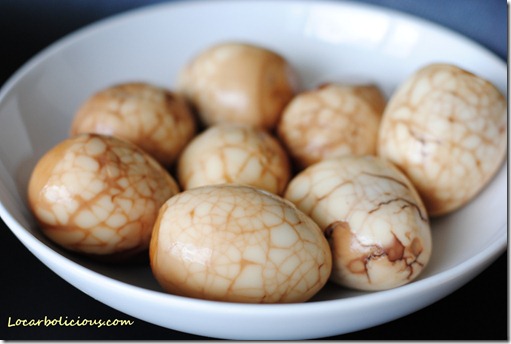
Ingredients:
Note: you can cook more eggs or fewer eggs in one go – the ingredients for the broth is the same. You can scale the broth up or down as long as the broth will cover all parts of all the eggs. My slow cooker is pretty big so I need a fair amount of broth to cover the eggs.
- 12 eggs
- 1.5 cups of soy sauce (or coconut aminos)
- 3 tablespoons of sea salt
- 4 cups of water
- 2 tablespoon of tea (I used loose green tea leaves as it was handy, but you can also use black tea). I think loose tea works best, but if teabags is all you have, then I would use around 6 bags (if it’s an American brand like Lipton) or 3 bags (if it’s actually from the UK).
- 6 star anise (optional, but highly recommended)
- 2 teaspoons of cinnamon or 1 cinnamon stick (optional)
- 1/2 teaspoon of ground cloves or 4 cloves (optional)
- 1/4 teaspoon of ground peppercorn (or better still, 1 teaspoon of whole szechuan peppercorns) (optional)
Directions:
- Place the eggs in a pot of cold water (choose a pot with a lid) and bring to the boil. Time 2 minutes starting when the water starts to boil. Then turn off the heat and put the lid on. Sit it there for around 10 minutes so that the eggs are hard boiled.
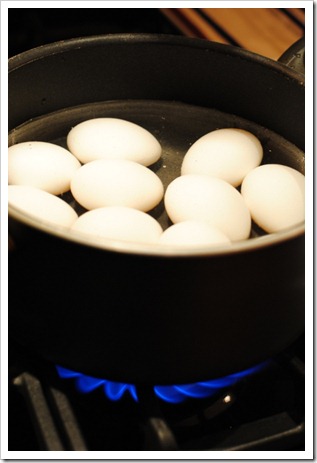
- While the eggs are cooking, prepare the the broth in a crockpot (slow cooker) or another pot with the other ingredients. Pour the soy sauce, water, salt, tea and optional ingredients into the pot and mix.
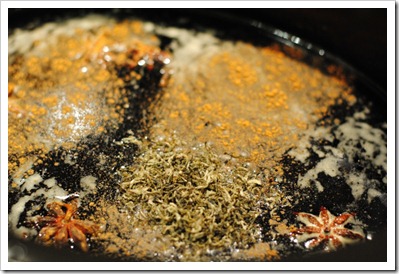
- When the eggs are done, sit the pot into the sink and run cold water into the pot for around 5 minutes – make sure the pot doesn’t block up the sink! This will cool the eggs.
- Once the eggs are cool, take a spoon and use the back of the spoon to break the shell. Make sure large parts of the shell doesn’t fall off, but it’s ok if a few small bits of shell come off. Break the shell all over. Do this for each egg. This will result in the eggs having that great marbling look.
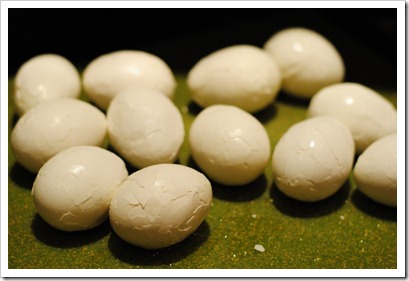
- Place the eggs (with the broken shell) into the pot with the broth. If you’re using the crockpot (slow cooker), then cook on a high heat for 4 hours. If you’re using a regular pot, then put the lid on and cook on the lowest heat on the stove for 2 hour (but check regularly to make sure the water isn’t boiling completely away – add more water if needed). You can shorten the cooking time, if you need to, but the eggs won’t be as flavorful.
- If you find the eggs are still not as flavorful as you’d like, then cool the entire pot down (don’t throw away the broth) and store the eggs overnight in the broth (in the refrigerator). This will help the broth seep into the eggs even more!
Marinated Grilled Flank Steak
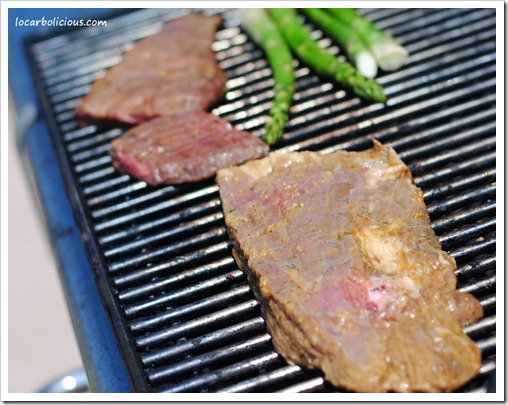
This is such a simple and delicious recipe and perfect for showing off your grilling skills without possessing any of those skills! It’s all in the marinade, and luckily, making the marinade just means dumping all the ingredients into a large bowl and stirring it. It’s also great because flank steak is such a cheap steak, so you can grill this all the time!
I made the marinade the night before and placed the flank steaks in the marinade overnight. There was so much flavor! I even reheated some left over steak in the microwave the next day, and it was still super tender and flavorful. So, here’s how to make it…
Marinade Recipe for Flank Steak
For 3 lbs of flank steak (usually two large pieces of flank steak that feeds at least 4 people):
- 1 cup coconut oil (or substitute with other oils)
- 2/3 cup soy sauce (or liquid aminos for a great gluten-free alternative)
- 1/2 cup red wine vinegar
- juice from 1 lemon
- 2 tablespoons of mustard
- 6 cloves of garlic, crushed
- 1 tablespoon of grated fresh ginger (I used a cheese grater)
- 1 tablespoon of paprika
- 1 tablespoon of dried chopped onion
- 1 tablespoon of salt
- 1 tablespoon of garlic powder
- 2 teaspoons of thyme
- 1 teaspoon of chili powder (it’s not spicy so feel free to add more chili powder if you like it really spicy)
How to Marinade Flank Steak
I sliced the 2 large flank steaks into halves so that it would be more manageable for marinating and cooking. I placed each of the 4 pieces of steak into a ziplock (sandwich) bag and poured some marinade into the bag. I carefully sealed the 4 ziplock bags and placed them into another plastic bag before putting them into the fridge overnight (I really didn’t want anything to leak into my fridge).
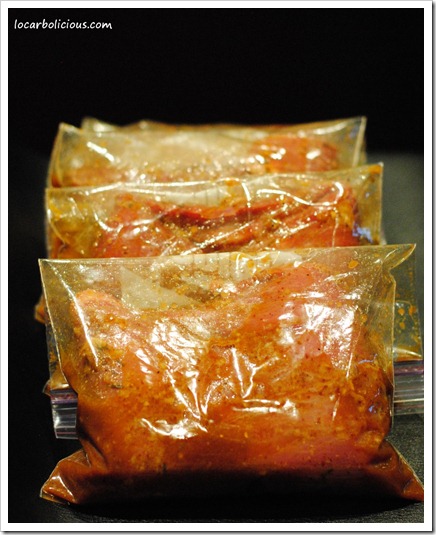
How to Grill Flank Steak
This part will vary a bit depending on the type of grill you’re using, how thick your piece of steak is, and how rare or cooked you like your steak. My apartment building has a nice gas grill on the roof, so I try to keep the grill temperature around 300-350F with the lid down. I like my steaks medium so I generally use tongs to see how soft the meat is getting. When the meat starts to feel less like the softness of raw meat and more firm, then it’s pretty much ready for me. This usually takes around 15 minutes. If you like your steaks rare, then cook it for less time, and if you like it well done, then keep it on the grill with the temperature under 350F for longer.
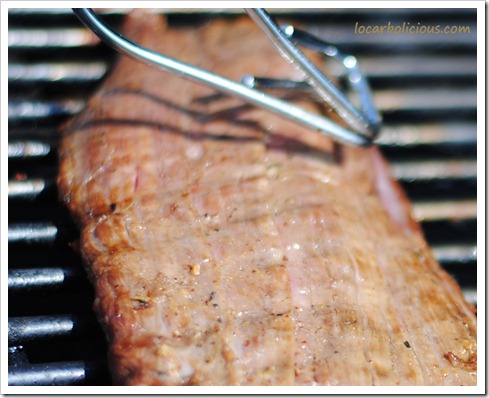
Cutting and Serving Flank Steak
Remember to cut against the grain (i.e. not parallel to the strings of meat fiber) if you’re slicing it up.

Or you can serve the steak whole with some grilled vegetables. The next photo shows approximately a 0.4 lb flank steak with some grilled asparagus. So, the marinade makes 8 pieces of steak that size.
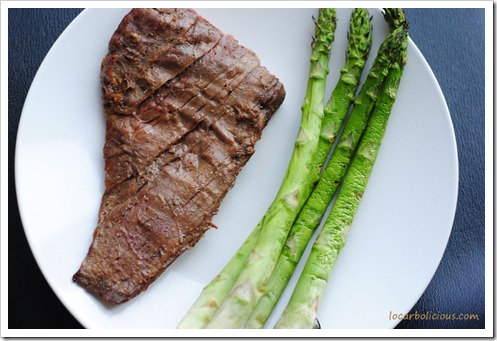
Vanilla Pound Cake: Grain Free and Sugar Free
I absolutely love all of Carolyn’s creations on All Day I Dream About Food. She has some amazingly delicious recipes and some even more amazing photos of her creations! If you’re hungry for desserts, then you should definitely check out her site – it will make your mouth water.
When I told Carolyn that I was grain-free (gluten-free) and low-carb, she suggested trying her almond crusted butter cake. Her recipe uses almond extract and is sweetened using erythritol, a sugar alcohol, and stevia. You can find that recipe here. I modified her recipe so that it wouldn’t contain any sugar alcohols (I also made it vanilla flavored). Instead, I’ve sweetened it with liquid sucralose (which contains fewer carbs than Splenda but is essentially the liquid version of Splenda).
This was a huge hit at a recent dinner party with a bunch of non-low-carbers! The little bit of protein powder in the recipe makes the texture soft and smooth – just like regular cake! Enjoy with a good cup of tea in the afternoon.
| Vanilla Pound Cake Recipe |
- 3 cups almond meal/flour (I’ve made the recipe using Bob’s Red Mill Almond Meal/Flour, which you can buy here (the recipe uses up pretty much a 16oz bag) and using my home-made almond flour, which is made by food processing raw almonds to create a coarse almond flour)
- 1/3 cup vanilla flavored whey protein powder (I love this vanilla ice-cream flavored one)
- 1.5 teaspoons baking powder (see this post if you want to eliminate the carbs in baking powder)
- 1 teaspoon baking soda
- pinch of salt
- 1/2 cup of butter, softened (I use the microwave for this)
- 3 large eggs
- 1 tablespoon vanilla extract (sugar-free)
- 3/4 cup sugar equivalent of liquid sucralose or other sweetener (I buy it from splendex.net)
- 1/2 cup almond milk
- Preheat oven to 300F.
- Butter a loaf pan (9in by 5in).
- Mix all the dry ingredients together.
- In a large mixing bowl, beat the butter and add in the eggs, one at a time. Add the sucralose and vanilla. Then add in the dry ingredients mix, followed by the almond milk. Beat well.
- Pour the cake batter into the loaf pan and bake for 60 minutes (the cake will rise in the oven and the top should turn golden brown). Let the cake cool for a few minutes before flipping it out. Cut into slices when it’s completely cooled.
Rosemary Thyme Roasted Vegetables Recipe
This is very healthy vegetable dish that tastes delicious and is easy to make. I modified it from a allrecipes.com recipe. You can change the sweet potato to an eggplant or some mushrooms if you want to lower the carbs.
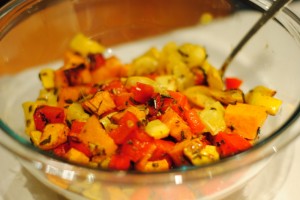
| Rosemary Thyme Roasted Vegetables Recipe |
- 2 yellow squash, cubed
- 2 red bell peppers, seeded and cubed
- 1 sweet potato, peeled and cubed
- 1 tablespoon fresh thyme, chopped
- 2 tablespoons fresh rosemary, chopped
- 1/4 cup olive oil
- 2 tablespoons red wine vinegar
- salt and pepper to taste
- Preheat oven to 475F.
- Mix together in a small bowl the thyme, rosemary, olive oil, red wine vinegar, and salt and pepper.
- In a large bowl, mix together all the vegetables with the mixture, so that all the vegetable pieces are well coated with the mixture.
- Place in casserole dish and bake for 35-40 minutes or until the vegetables start turning brown. Stir every 10 minutes to prevent the vegetables from sticking to the casserole dish.
Perfect Scrambled Eggs??
Ok, so you’re wondering what I could possibly say about scrambled eggs that you don’t already know! And two days ago, you would have been correct to wonder! But now that I’ve seen this video, I absolutely must share with you Gordon Ramsay’s PERFECT scrambled eggs.
If you think you already know how to make perfect scrambled eggs….think again! Apparently (according to Gordon Ramsay), even many of the most experienced chefs don’t know how to make good scrambled eggs! This is definitely not your typical scrambled eggs.
As you’ve probably heard before, the key is don’t overcook the eggs. But, this isn’t all that he does – with a few simple techniques, such as not whisking the eggs and not melting the butter prior to heating them, he creates scrambled eggs that are much creamier and much tastier.
I’ve tried to summarize the technique below, but I recommend you also watch the video (although ignore the part about bread if you’re on a low carb diet).
Who is Gordon Ramsay? For those of you unfamiliar with Gordon Ramsay, he is a fairly famous chef from Britain (there’s some good food in Britain, I promise!). He’s most famous in the US for the TV show, Hell’s Kitchen, in which he shouts and swears a lot (a lot!) in reaction to the mistakes made by aspiring chefs at the Hell’s Kitchen restaurant! I personally prefer the British TV show, Ramsay’s Kitchen Nightmares, where he visits various struggling restaurants and attempts to turn them around with varying degrees of success.
How to make PERFECT Scrambled Eggs:
[print_this]
Ingredients:
- 3 eggs (do not whisk! – this is very important!)
- 2 tablespoons of butter (unsalted)
- 1/2 tablespoon crème fraiche (or Crema Mexicana if you can’t find crème fraiche). I think the recipe also works without this ingredient, but it’s better with it.
- 2 teaspoons of finely chopped chives (optional)
- 1/4 teaspoon salt (or to taste), and a small amount of pepper
Directions:
- Crack the eggs into a pot and and add the chunk of butter to the pot.
- Put the pot onto medium heat and start stirring so that the eggs get broken up.
- Keep stirring without stopping. After around 2 minutes, the chunk of butter will have melted.
- Move the pot off the heat when you start to see some of the egg sticking a bit to the bottom of the pot. Keep stirring off the heat for about 10 seconds and then put it back on to the heat for another 20-30 seconds, but always keep stirring. Do this three or four times until you see that the mixture begins to become slightly more solid (but do not wait until it’s actually solid!).
- Once the eggs have just begun to solidify, take the pot off the heat permanently. Quickly stir in the 1/2 tablespoon of crème fraiche (or Crema Mexicana) and the chives.
- Lastly, season with salt and pepper.
How do the eggs taste? Delicious with a very creamy texture and taste. I also like how the chives add an extra dimension to the flavor. Can’t wait to try it with some smoked salmon like Gordon suggested in the video. Let me know how you like it!
Crackers
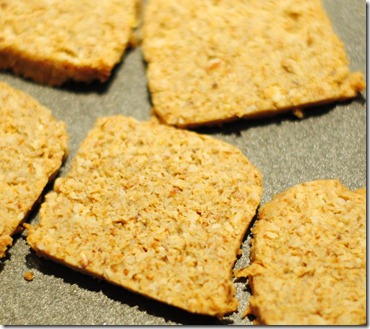 I saw a great recipe on Mark’s Daily Apple yesterday that I just had to try – crackers! You can dip them, spread cheese on them, or eat them by themselves. Of course, as Mark points out in his post, this is not something you should be eating for every meal just because it tastes so good, but it does make a great snack once in a while.
I saw a great recipe on Mark’s Daily Apple yesterday that I just had to try – crackers! You can dip them, spread cheese on them, or eat them by themselves. Of course, as Mark points out in his post, this is not something you should be eating for every meal just because it tastes so good, but it does make a great snack once in a while.
I’ve modified the recipe a little so that it’s not so crumbly, which makes it a bit easier to cut and cook. I substituted part of the almond meal for flax meal. This also adds some extra fiber to the cracker without really changing the taste or the texture. I’ve described the basic recipe below along with one option for seasoning, but you can change the seasoning to any spices that tickle your fancy.
Ingredients:
- 1 1/2 cups of almond flour (or almonds food-processed into small chunks)
- 1/2 cup of flax meal
- 1 egg
- 2 tablespoons of olive oil (I love the Columela Extra Virgin Olive Oil from Spain because it just has amazing flavor with everything!)
- seasoning: (3/4 teaspoon salt, 1/4 teaspoon basil. 1/2 teaspoon thyme, 1/4 teaspoon oregano, 1/2 teaspoon onion flakes, 1/4 teaspoon garlic powder)
Directions:
- Preheat oven to 350F (175C).
- Place all the ingredients into the food processor and food process well to make a dough.
- Shape dough into a log (as shown in the photo below) or roll into a flat sheet using tin foil or parchment paper.
- Place in fridge for 10 minutes to harden the dough.
- If you made it into a log, then cut into thin slices (1/3 of an inch). If you rolled it into and then cut into cracker shapes using a pizza cutter or knife).
- Place crackers onto baking tray and bake for 10-12 minutes.
- Let cool and store in the fridge over night (this hardens them even more).
Nutritional information (per cracker): 76 calories, 6.7g fat, 2.6g carb (1.7g fiber), 2.7g protein.
Baking Soda Vs. Baking Powder–Is There a Difference?
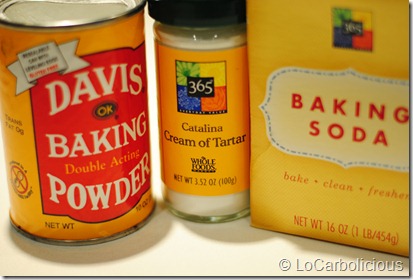 If you’ve ever baked normal (full of carbs) cookies, cakes, or breads, then you have probably used baking soda or baking powder. You might also have come across cream of tartar perhaps. These are all common ingredients that you can find in the baking section of most grocery stores. For a long time, I thought baking soda and baking powder were the same thing and could be used interchangeably. I don’t really know why I thought such a thing – but it does explain why I wasn’t particularly good at baking before!
If you’ve ever baked normal (full of carbs) cookies, cakes, or breads, then you have probably used baking soda or baking powder. You might also have come across cream of tartar perhaps. These are all common ingredients that you can find in the baking section of most grocery stores. For a long time, I thought baking soda and baking powder were the same thing and could be used interchangeably. I don’t really know why I thought such a thing – but it does explain why I wasn’t particularly good at baking before!
What is Baking Powder? This is usually a combination of baking soda with an acidic agent (such as cream of tartar, which is described below) along with some other ingredients, such as cornstarch. Baking powder produces carbon dioxide bubbles, which expand in the oven (due to the heat) so that your baked goods will rise and become light and soft. Baking powder can come in two versions: single-acting and double-acting. Single-acting means that as soon as you add the powder to anything wet, it’ll start giving off carbon dioxide bubbles, so you’ll need to put your mixture into the oven quickly to avoid running out of bubbles. Double-acting means that although some of the bubbles are released when you first add the powder to your mixture, most of the bubbles will come out when the mixture heats up in the oven. Therefore, you don’t have to worry about leaving your mixture out for too long when it comes to double-acting powder.
Why is Baking Powder Problematic on a Low Carb Diet? Many low carb diets discourage cornstarch or any other type of starch, but this is unfortunately an ingredient in most brands of baking powder. The starch doesn’t actually add much to the cooking, but it does stop the baking powder from getting moist and clumping together. So, while the baking powder states that it contains less than 1g of carb, you should remember that its serving size is 1/8 of a teaspoon and most recipes call for at least a teaspoon or more (there are 2g of carbs per teaspoon of baking powder). If you’re not super strict on your low carb diet, then a teaspoon of baking powder is not going to be a problem. However, if you’re really counting every carb, then you can make your own starch-free low carb baking powder by using cream of tartar and baking soda combined. A simple recipe for making baking powder is below, but first let me briefly explain what baking soda and cream of tartar are.
What is Baking Soda? It’s 100% sodium bicarbonate, which reacts with anything acidic in your baking mixture to produce carbon dioxide bubbles. These bubbles will start forming as soon as the baking soda touches the acidic ingredients, so you need to bake your mixture fast (otherwise, the bubbles will die out).
What is cream of tartar? This is a white powder (potassium hydrogen tartrate) that is an acidic salt. It’s occurs naturally as one of the by-products of wine-making. It has many uses in foods, the most well-known of which is stabilizing beaten egg whites. Other uses include giving icing and meringue a creamy texture (hence its name I assume) and reducing discoloration of vegetables when boiled. For low carb dieters, it has another use. When added to baking soda, it makes a carb-less baking powder that works just as well as normal baking powder! There have been some health concerns about cream of tartar. First, it is high in potassium, which can be problematic for people with kidney disease or taking medications that prevent the kidney from getting rid of the potassium effectively. When taken in large amounts, cream of tartar can also be a laxative. However, the amount used in normal cooking is generally not a problem.
Low Carb Cookies – Peanut/Almond Butter Cookies that Don’t Crumble!
Yes, delicious low carb cookies do exist, and you are looking at a photo of them!!
I tried making low carb cookies several months ago but gave up after finding them to be too crumbly. However, my interest was piqued again this past week when my cafeteria served flourless (gluten free) peanut butter cookies. They were a sell-out! But, making a flourless cookie was only half the battle – I still needed to get rid of the sugar in the cookies. I’ve described my trial and error process below, but you’ll love the ending (I did)….
Crumbly Cookie: I looked up a simple flourless peanut butter cookie recipe, which was really simple: mix together 1 egg with 1 cup peanut butter and 1 cup sugar, and then bake for 10 minutes at 375F. I tried the simple substitution of liquid sucralose for sugar. The cookies came out delicious but incredibly crumbly – in fact, I could barely get the cookie to my mouth before it disintegrated into powder. The cookies were vanishing into dust, and I wasn’t even eating them!
Substitute Splenda For Sugar: Next, I tried using Splenda. Although I’m not usually a big fan of Splenda (because of the bulking agents it adds), my cookies were in dire need of some sort of bulking agent! The cookies came out less crumbly, but were still very dry and all-too-eager to break into pieces.
Xanthan Gum? I took some serious action after that by adding in some xanthan gum (which is a thickening agent that’s great in soups like egg drop soup). This made the cookies more coherent, but it also gave it a chewy texture – reminiscent of Japanese mochi or rice balls (both which are generally made from glutinous rice flour).
Eureka: I soon (after quite a few more batches!) realized that perhaps eggs could act as the glue in this recipe. But I couldn’t just add more eggs in – it would make the recipe way too liquidy. I had to add something in with the eggs. That’s when it came to me…flax meal. The xanthan gum went out and the flax meal and extra eggs came into the mixture. The cookies came out more solid, with a texture rather like oatmeal! Success at last.
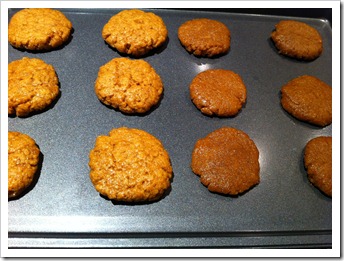 Making the Cookies Rise: Now that I had figured out how to make the cookies not crumble, I turned to the problem of making them rise. I wanted cookies that were lighter and less dense. Baking powder and baking soda are the common ingredients for making baked goods rise. To minimize usage of baking powder (because it contains a little bit of unnecessary carbs), I used cream of tartar instead. I’ll explain in my next post what all that means. Basically, I tried adding just baking soda (the cookies on the right), and then both baking soda and cream of tartar (on the left), and the cookies definitely rose more with both ingredients (even before putting it into the oven)! As you can see, cream of tartar also lightened the color of the cookie. (The photo shows the cookie dough prior to cooking.)
Making the Cookies Rise: Now that I had figured out how to make the cookies not crumble, I turned to the problem of making them rise. I wanted cookies that were lighter and less dense. Baking powder and baking soda are the common ingredients for making baked goods rise. To minimize usage of baking powder (because it contains a little bit of unnecessary carbs), I used cream of tartar instead. I’ll explain in my next post what all that means. Basically, I tried adding just baking soda (the cookies on the right), and then both baking soda and cream of tartar (on the left), and the cookies definitely rose more with both ingredients (even before putting it into the oven)! As you can see, cream of tartar also lightened the color of the cookie. (The photo shows the cookie dough prior to cooking.)
THE RECIPE
Ingredients (12 cookies):
-
1 cup peanut or almond butter (make sure it has no added sugar or salt or anything else!)
-
2 eggs
-
1 cup equivalent of Splenda
-
1/2 cup of flax meal
-
1/2 teaspoon baking soda
-
1 teaspoon cream of tartar
-
Optional: 2 tablespoons vanilla extract, 2 tablespoons of cinnamon, 1 teaspoon of nutmeg, 1/8 teaspoon of ground cloves (if you don’t really like the taste of nuts, then these will hide the nutty flavor well)
Directions:
-
Preheat oven to 375F.
-
Mix the dry ingredients (Splenda, flax meal, baking soda, and cream of tartar together).
-
Add the peanut/almond butter and the 2 eggs.
-
Shape into 1 and 1/2-inch balls and flatten into cookies.
-
Bake in oven for 8 minutes.
-
Leave to cool (they’ll harden a bit more upon cooling).
Note: the dough may look rather oily before you put it into the oven (and I think the cinnamon might draw some of the liquids out of the dough so that it looks like your dough is sitting in a puddle of water), but it comes out non-oily and moist on the inside!
